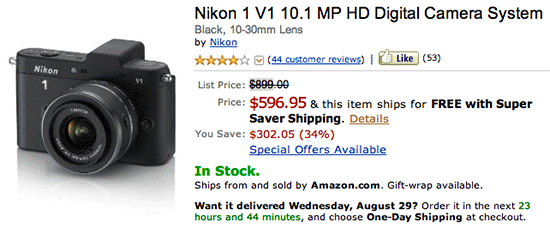Nikon 1 Lens On D7000
Here's a video of the new Nikon Lens AF-S DX NIKKOR 18-300mm f/3.5-5.6G ED VR on a Nikon D7000 DLSR camera. This new lens is ultra-high-power 16.7x all-in-one zoom lens with Nikon's second-generation Vibration Reduction (VR II) for sharp images in varied shooting situations.
It's compact and lightweight, an extremely versatile all-in-one DX-format lens.According to NikonUSA's website, this is Nikon's most powerful all-in-one zoom lens ever. It is a single lens that can cover every imaginable shooting situation, from wide-angle groups to ultra-high-power zoom shots.
It has the longest reach of any NIKKOR all-in-one zoom lens, it delivers the equivalent of 450mm, bringing the most distant action up close. Nikon's second generation VR II technology ensures every photo and HD video is razor-sharp, and Nikon's advancements in lens design deliver consistent, exceptional performance in any setting. It's also great for close-up shooting. Even more amazing, the AF-S NIKKOR 18-300mm f/3.5-5.6G ED VR does all this in a surprisingly compact, lightweight lens.The D7000 is my very first DSLR.



(The Camera to Lens Compatibility Chart has been updated 12-JAN-2016 with the latest additions to the Nikon lineup, the D5 Pro FX DSLR and the long awaited D500, the DX successor of the beloved D300/D300s.) From time to time you find yourself reading great reviews on some lenses or see a bargain. CPU lenses (particularly types G and D) are recommended, but note that IX-NIKKOR lenses can not be used. CPU lenses can be identified by the presence of CPU contacts, type G and D lenses by a letter on the lens barrel. Type G lenses are not equipped with a lens aperture ring. The maximum aperture of the lens is given by the f-number in the lens.
Nikon 1 Lens On D7000 Review
While D5100 and D3100, packaged with zoom lenses (55-200), are on sale these days, I just thought of having one lens (18-300) that came out a few weeks ago would be much better.Well, I've got mine and I'm sharing the looks of it with other non-professional photographers (like me), especially those in doubt of what to get.This camera is supposed to be excellent. And I have to learn its features. The limitations will be me.:)This video was taken with a Sony Cybershot TX7.7-7 Cheers!
Review based on a production Nikon D7000 with firmware V1.00, 1.00, 1.002When it was announced in September the D7000 took a lot of people by surprise. Although a D90 successor had been on the horizon for some time, what wasn't expected was how close in specification terms the new camera would turn out to be to the D300S.
In some respects, in fact, the D7000 actually outguns its (supposedly) semi-pro cousin, and offers a compelling upgrade option to both D90 and D300S owners, whilst nominally sitting between the two in Nikon's current lineup.Although ergonomically, the D7000 is a very close match for the D90, its overall 'feel' is considerably more serious, thanks to a magnesium alloy body shell and slightly thicker rubber coating on the hand grip and rear of the camera. At 16.2Mp the D7000 offers the second highest resolution of any Nikon DSLR, behind only the 24Mp D3X. All of these pixels are packed onto a newly developed CMOS sensor, which is almost certainly the same or very similar to that in the. As well as extra resolution, the new sensor also offers a higher 'standard' ISO span of 100-6400, expandable up to the equivalent of ISO 25,600.The D7000's AF and metering systems are also new, and represent a significant upgrade to those used in the D90.
The new camera boasts a 39-point AF array with 9 cross-type AF points and works in collaboration with a new 2016-pixel RGB metering sensor to allow 3D AF tracking (essentially tracking by subject color, ). Other changes include the same combined live view/movie switch control as the 3100, and a significantly upgraded movie specification, up to 'full HD' - 1920x1080 resolution at 24fps. Unlike the D90, the D7000 can also maintain AF during live view and movie shooting, thanks to its AF-F ('full time') AF mode.D90 owners have been waiting for a replacement camera for a while, and although the D90 isn't set for retirement quite yet, the D7000 certainly represents a compelling upgrade. It took longer than we'd hoped for a production D7000 to be supplied to us, but now that we've had one for a a few weeks we've been able to produce an in-depth review.
Read on to find out what we think of Nikon's newest DSLR. I recently upgraded or downgraded 'depending on how you look at it' from the D3200 to the D7000. Although I lost MP, I gained a lot more features. My first D7000 had serious focus, back focus, and pixel issues.
After contacting the seller and receiving another one, I finally had a good one and was very pleased. Years ago I had a D5100 which is said to have the same sensor as the D7000, but I find the D7000 images to look much better.
I would recommend the D7000 to anyone serious about photography but not able or willing to spend too much money. Be sure you use a good prime lenses like a Nikkor 35mm f1.8 or the 50mm f1.8. Otherwise you will be wasting your time and/or money. Just Posted: Our review of Nikon's D7000 mid-range DSLR. Nikon surprised many people by pushing its enthusiast DSLR distinctly up-market just as Canon was doing the opposite with its 60D. The result is such a highly specified camera that it's generated almost as much interest from existing and would-be D300S customers as from the traditional D90 audience.
So, after our usual in-depth testing and real-world use, what do its 16 megapixels, 39 AF points, 6 frames per second and 14-bit RAW add up to? Read our full review of the Nikon D7000 to find out.